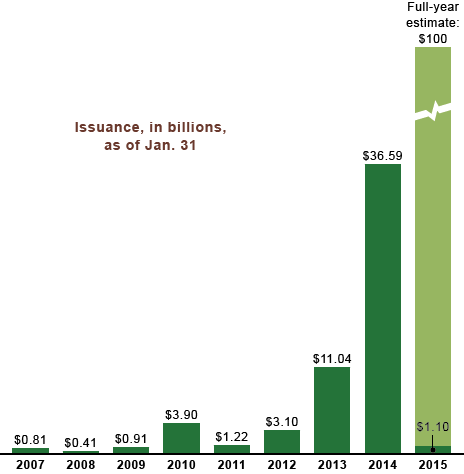A number of important green bonds market developments in February meant a buzzy month for the media coverage. The trending topics were India’s first green bond, Deutsche Bank’s €1 billion green bonds commitment and Oslo Stock Exchange green bonds listing. We have also seen the role of the governments in scaling up the market highlighted in a number of articles.
Business News Network, Buy green bonds, feel good about yourself
Andrew Bell of Canadian Business News Network's 'Commodities' interviews Climate Bonds Initiative CEO Sean Kidney.

click on the image to see the interview
Share Radio, Investment Perspectives, ‘Interview on climate bonds’
Ed Mitchell of the Investment Perspectives program interviewed Sean Kidney about the green bonds phenomenon, effects of falling oil prices on renewables and more.
Investment & Pensions Europe, Yielding results, by Jonathan Williams (in Special Report ESG: Carbon Risk)
A lot of interesting reading in Investments & Pensions Europe’s February special report: ESG: Carbon Risk. Jonathan Williams in his article ‘Yielding results’ touches on two important challenges facing the green bonds market: the need to develop a large and liquid market (government role stressed) and to standardize ‘green’.
The increased activity in the market has seen the matter become mainstream, with large investment houses now showing an interest in the field. But institutional investors concede that work is needed to guarantee the development of a sufficiently deep and liquid market, leading to calls from asset owners worth $2.2trn (€1.9trn) for governments to kick-start the market by offering guarantees and tax incentives.
Investment & Pensions Europe, How green are your govvies?, by Mike Scott
The article highlights the risks associated with the sovereign bonds portfolios’ carbon exposure and talks about potential for governments to start issuing the sovereign green bonds.
With interest in how countries are tackling climate change increasing, and the market for green bonds growing rapidly, a logical next step is for governments to start issuing sovereign green bonds. None have been issued at sovereign level yet, but there are several sub-sovereign green bonds, from bodies ranging from the city of Johannesburg to the US states of Connecticut, Florida and California.
“I fully expect to see sovereign green bonds in the near future,” says Kidney. “There is a growing chance that we will see a flurry in the lead-up to the COP meeting in Paris.”
Europe’s World, Green bonds: How to grow the market, by Sean Kidney and Beate Sonerud (Climate Bonds Policy Analyst)
An article published in the European policy journal talks about the key role of policymakers in scaling up the green bonds market.
As the timing of climate investment matters to minimise climate change and its impacts, we cannot wait for the risk-return profile of low-carbon investment opportunities to improve on its own. Investment opportunities need to be created at a much greater speed, but so far policymakers have made only limited use of their policy toolbox to do this. Even though there are many available policies in the real economy like feed-in-tariffs, there are few examples of financial tools and instruments used explicitly to support low-carbon investments.
Cities Today, Green bonds: connecting China’s enormous savings pools and citizens’ concerns for the environment to finance green urbanisation (p. 65), by Sean Kidney
Sean Kidney sees a potential for China and its cities to take a global leadership role in the face of the enormous environmental challenges. He claims China’s central government began to recognise the opportunity that comes with green bonds.
The dual challenges of vast new infrastructure requirements and environmental challenges China is currently facing makes it clear that the extraordinary achievements of China, in bringing one billion people out of poverty with the fastest industrial transformation in history, must now be replicated in an unprecedentedly rapid shift to a Green Economy. This transition to a low carbon and green economy needs huge amounts of funding. (…) As China’s financial markets mature bonds will become an increasingly important financing instrument in China and therefore also in funding the shift to green.
IFR, India signals potential for Green bonds, by Manju Dalal
Following the first green bond offering from the India’s bank; Yes Bank, author claims green bonds have been identified as one of the key financing tools to meet India’s aggressive renewable energy targets. But challenges like the high interest rates remain.
India desperately needs a deeper corporate bond market as the cost of capital for doing business here is too high,” Kidney said. The cost of renewable energy is 24%–32% higher in India compared with the US or Europe because of higher debt costs, according to USAID. “One of the ways to address the higher costs is to diversify the investor base. The Green bond market can exactly offer that,” Kidney said.
Bloomberg, Deutsche Bank Seeks to Buy $1 Billion in Green Bonds, by Stefan Nicola
Author of the article sees the Deutsche Bank’s commitment to boost its investment in green bonds as an evidence that ‘the green bond market is blooming’.
Investors are snapping up bonds to finance the global expansion of clean energy, promoted by governments from the U.S. to China to tackle climate change. The debt, issued by development banks or by project sponsors themselves, offers investors an alternative to volatile equities.
World Bank, Green Bonds Are Changing Investor Expectations & Making Sustainable Investing Easier
Analysis of the green bonds market trends from the World Bank.
A year ago in Davos, World Bank Group President Jim Kim encouraged investors at the World Economic Forum to take a closer look at green bonds, a relatively new but growing option for investing in a sustainable and responsible way: Green bonds act like other bonds, but they can help fill gaps in much-needed development finance for climate-friendly projects.
Barron’s Asia, A Feel Good Way To Boost Your Portfolio, by Abby Schultz
Author says that green bonds help Asia’s private banks meet wealthy clients’ demands for sustainable investments.
Asia’s private bank customers are becoming more interested in sustainable investment strategies, including impact investing – the idea of investing for the good of society while still getting a decent return – but, unlike in Europe or the U.S., these strategies are only slowly taking root. (…) For now, even for institutional investors, there are few investment choices in Asia that meet ESG criteria, although the World Bank’s straight-forward green bonds – designed specifically to fund climate-related projects – have been available in the region as have green bonds from the Asian Development Bank, the Development Bank of Japan and the Export-Import Bank of Korea.
Cities Today, Gothenburg: a pioneer in green city bonds
An interview with the Head of Group Treasury in the City of Gothenburg Magnus Borelius; first-hand practical information about extra steps issuing municipality has to take when issuing a green bond vs. ordinary bond, pooling of assets and verifying green credentials. Also, an insight to Gothenburg future green bonds plans.
Richard Forster: What is the pipeline for future green bond issuance? Is the SEK2 billion green bond programme still the overall aim?
Magnus Borelius: We will try to have at least one green bond annually. The total volume for ‘green’ or ‘sustainable’ investments is much larger than SEK2 billion [US$275 million] and we see a lot of projects in the future, which can be funded this way. If the maturity profile for the city is right, we will try to switch from ordinary bonds to green bonds as much as possible. Our biggest challenge right now is to find the right quantitative and qualitative performance indicators. (…)
Meeting of the Minds, What Are Green Bonds and Why All the Fuss?, by Marilyn Ceci
A thorough overview of the green bonds market by Head of Green Bonds at JP Morgan and one of the staunch green bonds supporters.
There are no tax advantages to owning a Green Bond compared with a traditional bond. However, Green Bonds offer issuers and investors a great opportunity to make sustainable, climate-friendly investments. In addition, research shows that companies which include environmental, social, and governance issues into their corporate strategy financially outperform those that do not.
Environmental Finance, Development banks in initiative to harmonise green bond impact reporting, by Peter Cripps
EF reveals details of an initiative of a number of development banks convened in an informal working group to produce ‘a harmonised guidelines for reporting the impacts of green bonds’.
The drive to produce harmonised guidelines is a response to demand from investors, who are increasingly asking to see the annual reporting of expected impacts of projects supported by green bonds, using metrics such as tonnes of carbon dioxide abated or tonnes of waste avoided or safely disposed.
Dagens Næringsliv, (Norway’s financial newspaper), Børsens grønne bidrag, by Trude Myklebust
The article talks about the launch of the Green Bonds Exchange by the Oslo Stock Exchange. The author highlights the importance of the exchange’s main inclusion criteria for bonds: 2nd opinion on the bonds’ green credentials. Also read our coverage of the announcement.
Ut fra børsenes tradisjonelle rolle ligger det muligens ikke i dagen at de skal se det som sin oppgave å bidra til et grønnere kapitalmarked. Men her kan børsene ha flere motiver. Dette kan være å øke kvaliteten på de noterte instrumentene i markedet, samt tilhørende informasjonstilgang. Og det kan være et forretningsmessig basert ønske om å tilby produkter som markedet etterspør, noe blant annet det store tilfanget av ulike internasjonale bærekraftsindekser viser.
Pensions & Investments, Green shots, by Tim Pollard
P&I’s visual demonstration of the ‘hot’ green bonds market – multiple graphs present trends over the last few years.

EI Energy Intelligence, Green bonds grow in popularity, eyed as useful tool, by Philippe Roos
EI’s report of the green bonds market growth highlights the benefits that green bonds offer to issuers and investors.
A €2.5 billion ($3.4 billion) green bond issued by GDF Suez last May was intended to strongly demonstrate its commitment to the ongoing energy transition, Anne Chassagnette, in charge of environmental and societal responsibility at the French utility, told EI New Energy. It allowed SRI investors, which own some 10% of the group’s equity and account for an increasing share of the financial industry, to also participate in its debt — a welcome diversification given how much capital an energy company needs, she added.
Banking Day, Green bonds attract orange light from Aussie bankers, by Bernard Kellerman
Bernard Kellerman reports on his meeting with Sean Kidney in Sydney.
Australian banks are also warming to green bonds. (…) "Their treasury people think it's a good angle [to access funding slightly more easily] while their origination teams like the angle of attracting new clients or offering a more interesting deal to existing corporate clients in the bond market," Kidney said.
Sourceable, The Outlook for Green Bonds in Australia for 2015, by Marc Howe
Another article focused on the Australian perspective for green bonds.
Intensifying concern over climate change and increasingly conscientious decision-making on the part of institutional investors are expected to provide a major boost to the global market for green bonds.
Inside Climate News, Divestment Push Has More Small Investors Wanting Fossil-Free Portfolios, by Elizabeth Douglass
The article talks about options available to a growing number of investors who partake in the fast-growing divestment movement.
Investors are particularly interested in so-called green bonds, which are issued much like the kinds of bonds that finance government infrastructure projects. The funds raised by the sale of green bonds, however, are earmarked for things like solar power facilities, energy-saving retrofits and commuter rail projects. In 2014, investors worldwide snapped up $36.6 billion in climate-related bonds, more than triple the 2013 total of $11 billion, according to Sean Kidney, chief executive officer of the Climate Bond Initiative
Sustainable Business, The Green Bond Rush Continues, by Rona Fried
Author covers the latest developments in the green bonds market and provides an update on the work of the Climate Bonds Standard expert committees.
Standards for Green Agriculture Bonds and Green Forest bonds are expected to be finalized by June, and Water bonds by year-end.
"There's an urgent need for investments that help reduce deforestation and help with climate change adaptation in vulnerable agricultural areas. This is especially important as food crops are already being affected by climate change, contributing to global food price volatility. The right kinds of investment in agriculture also have the potential to help sequester enormous amounts of carbon," says Sean Kidney, CEO of the Climate Bonds Initiative.
SeeNews.Renewables, Overview: USD 1.1bn green bonds issued in Jan 2015, 73% by TerraForm, by Tsvetomira Tsanova
In February, the renewable energy newswire: SeeNews.Renewables started the monthly green bonds market review.
“Great to see that pure play renewable energy companies decide to add the green bond label on to their issuances,” commented CBI chief executive and co-founder Sean Kidney with regards to TerraForm's transaction. He stressed that the total outstanding bond issuances for climate solutions without the green label is much larger than the green labelled bond market; the former stood at USD 502.6 billion as of June 2014 compared to USD 53.2 billion of labelled green bonds outstanding at the end of 2014. "So, here’s a challenge for the pure plays out there - get on labelling your bonds as green," Kidney said.
GreenBiz, Green bonds and beyond: 4 ways to fix water infrastructure, by Will Sarni
Will Sarni, director with Deloitte Consulting LLP, summarizes the conclusions of the a recent Circle of Blue report that tackles ways of adjusting US water infrastructure to impacts of climate change. Green bonds are part of the mix.
Late last year (Climate Bonds Initiative) established a water infrastructure working group to develop criteria for water investments that can be used to back green and climate bonds certified under the Climate Bond Standard. The group is charged with developing criteria for water related investments in the areas of “clean water projects, water treatment infrastructure, agricultural usage, storm and flood drainage and protection.
+ lots of green bonds news in Environmental Finance’s green bonds section: : Oekom sustainability rating service, India’s first green bond, Oslo Stock Exchange green bonds list , investors’ call for green bonds standards and much more.

